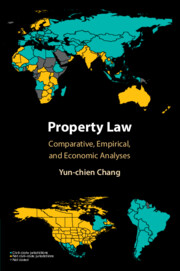Book contents
- Property Law
- Property Law
- Copyright page
- Dedication
- Contents
- Detailed Contents
- Figures
- Tables
- Citation Format
- Acknowledgments
- Abbreviations
- Introduction
- Part I Foundation
- Part II Immovable Property
- Part III Movable Property
- 10 Good-Faith Purchase
- 11 Finders, Keepers
- 12 Specificatio
- 13 Accessio and Confusio
- Conclusion
- Book part
- References
- Index
10 - Good-Faith Purchase
Proposing Fractional Ownership and Internal Auction
from Part III - Movable Property
Published online by Cambridge University Press: 18 May 2023
- Property Law
- Property Law
- Copyright page
- Dedication
- Contents
- Detailed Contents
- Figures
- Tables
- Citation Format
- Acknowledgments
- Abbreviations
- Introduction
- Part I Foundation
- Part II Immovable Property
- Part III Movable Property
- 10 Good-Faith Purchase
- 11 Finders, Keepers
- 12 Specificatio
- 13 Accessio and Confusio
- Conclusion
- Book part
- References
- Index
Summary
Chapter 10 identifies 21 variants of the good-faith purchase doctrine, which are often different combinations of several key factors. That said, none of the 21 schemes are the most efficient. Among the forms of good-faith purchase doctrine currently in use, the market overt rule comes closest to ex ante efficiency because original owners, merchant dealers, and consumers all have incentives to spend close to optimal costs on verification and prevention, and the movables in question are more likely to be in the hands of higher valuers. Drawing on mechanism design literature, Chapter 10 argues that when both an original owner and a consumer are non-negligent, the two parties can be assigned 50% shares of the movable in question, and an ensuing internal auction between them can ex post tease out who values the resource more. This internal auction design is inexpensive to administer.
Keywords
- Type
- Chapter
- Information
- Property LawComparative, Empirical, and Economic Analyses, pp. 259 - 288Publisher: Cambridge University PressPrint publication year: 2023

